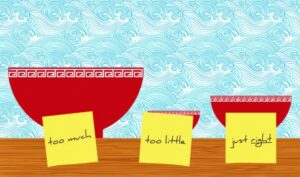 It can be really helpful when we our lives are unsettled or disrupted by states or moods that feel unsafe or unwanted to do some tracking of these states throughout the day.
It can be really helpful when we our lives are unsettled or disrupted by states or moods that feel unsafe or unwanted to do some tracking of these states throughout the day.
These unhappy states can be seen as a kind of inner protest: a protective, shut-down or closed-down reaction on the part of our nervous systems to what’s going on around us (i.e. the dorsal vagal collapse of depression). Or alternatively a more flurried reaction to the perceived too-muchness of our environment in the form of hyper-mobilised anxiety, worry, or panic states (a sympathetic nervous system response).
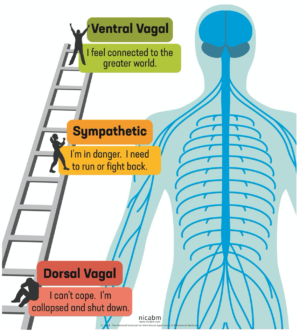
Ideally, we want to spend as much time as possible in that “Goldilocks Zone” of our autonomic nervous systems, which is to say in a Ventral Vagal state: safe-&-connected (3rd gear, see below) , or in the more mobilised, activated sympathetic-flow state of our 4th gear.
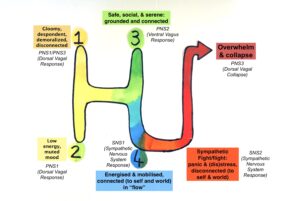
HOW TO TRACK YOUR STATES ON A DAILY BASIS
There are of course apps that do this kind of thing. Here’s a few screenshots from Moodily, for example.
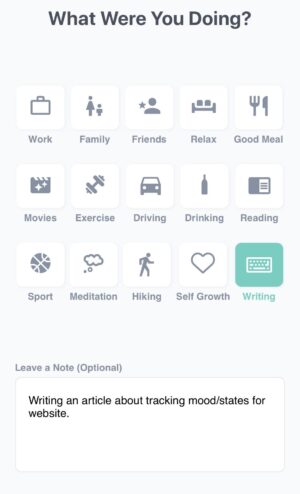
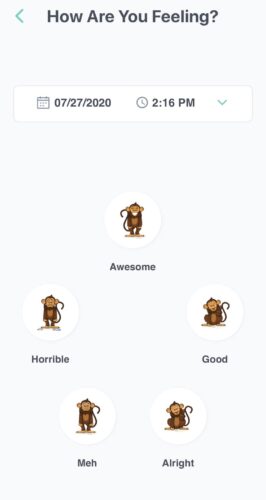
If you’d prefer to use an app, go for it, but I quite like doing this in a more analogue way. I also think it’s easier for you to see when and how you move into, out of and through different states by using some old-fashioned paper and colouring in pencils or markers.
This also helps us when it comes to looking back at the week just past and assessing what we can do to help you move you out of anxious/depressed states more quickly, as well as cultivating and nurturing those safe and connected glimmer-and-glow ventral vagal states so that you benefit from having more of these in your life.
Instructions for Basic State/Mood tracking (with examples)
At the end of each day, take a couple of minutes to write down as a list everything you did on that day (from the moment you woke up to when you plan to go to sleep). Then take some coloured pencils or pens, and show through colour the state(s) you were in whilst travelling through (or stuck in) these experiences.
You don’t need to write this up in an exhaustive way. Just the main “beats” of the day. Here are a couple of examples from a client who has allowed me to share (anonymously) her state tracking over a period of four days.
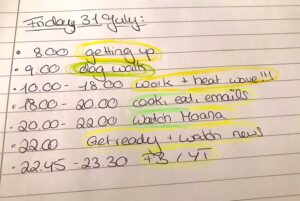
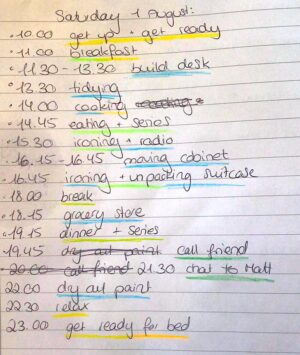
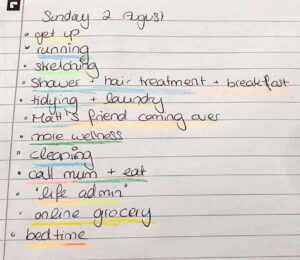
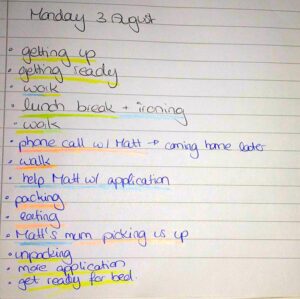
As you can see from the above example, using this method can help us to spot a number of factors that are really useful when understanding yourself and your states/moods/emotions :
-Activities that promote, shape, or nudge us into welcome states (usually green/3rd gear, or blue/4th gear/FLOW states).
-Activities or situations that promote, shape, or nudge us into unwelcome states (usually yellow/depressive gears, or orange-red/F-gear). Examining these together, we can start to understand better what “danger cues” your nervous system might be picking up on, either from your external environment (work, relationships, living conditions) or internal environment (thoughts, internal dialogues, substance or diet-influenced nudges, or body state feedback due to exercise or lack of).
-The extent to which a somewhat positive/welcome state (green, blue) will often have little tendrils of unsafe (orange/red) energies mixed in with the pleasant stuff, which is good to be aware of, and monitor, just in case that danger cue takes us deeper into a protective survival state (full-blown yellow, orange, or red).
-The extent to which unwelcome states (yellow, orange, red) will also often have little little glimmers of safety (blue, green) in them, even if they last only a second or two. This can be really useful for us to see, albeit retrospectively, as those glimmers are often cues of safety which we might want to deepen and use as a kind of “handhold” to climb back up the ladder into our OK, or “home” state of ventral vagal.
(In Schema Therapy, this “home” state is called “Healthy Adult Mode”, in IFS it’s called “Self”, and in psychodynamic or psychoanalytic language, we might refer to Functional Ego States).
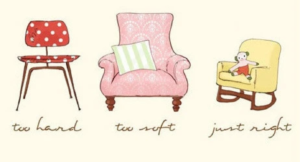 So you could say that these daily state-tracking records are also a kind of snapshot or map of how your mind and nervous system are taking you through the merry-go-round of your life. How much time your system is being knocked (triggered) into a too-much reaction (sympathetic nervous energy), that rollercoaster of anxiety, anger, avoidance and frustration; as well as the amount of time in dorsal vagal, that collapsed too-little carousel of depression and stagnation.
So you could say that these daily state-tracking records are also a kind of snapshot or map of how your mind and nervous system are taking you through the merry-go-round of your life. How much time your system is being knocked (triggered) into a too-much reaction (sympathetic nervous energy), that rollercoaster of anxiety, anger, avoidance and frustration; as well as the amount of time in dorsal vagal, that collapsed too-little carousel of depression and stagnation.
If you’re artistically inclined, you might decide to do something a little more funky. Here’s an example of a day rendered in watercolour pencils, paying homage to the loopy-nature of our experience!
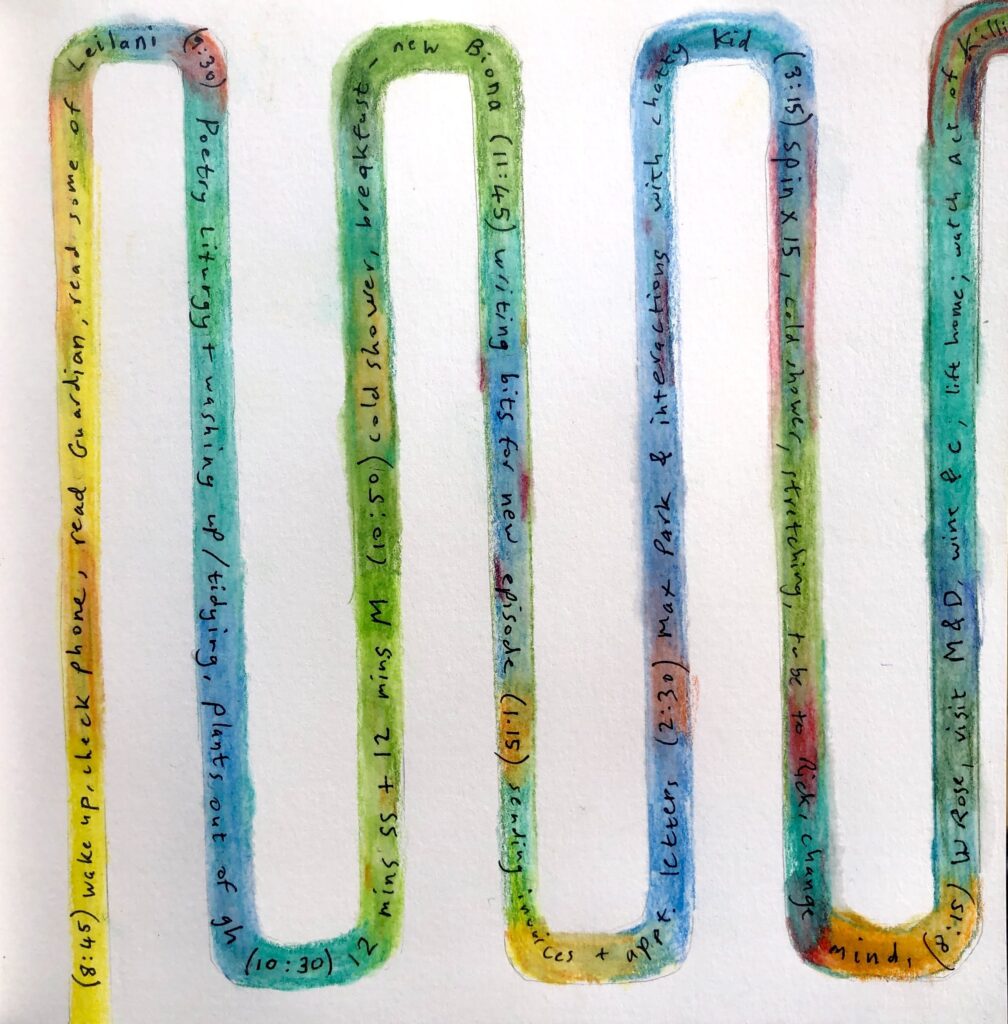
If you don’t like the idea of using colours or listing/looping your day as I’ve shown above, here are a couple of other ways to do it. The more creative you can be with this, the more interesting or fun you can make it, the easier it will be to keep up the tracking for a period of time (minimum of a week). Tracking needs to be done for a while in order to give us enough data to start understanding better how and why you move into and through different states/moods/emotions.
But even if just track a couple of days, especially some difficult or challenging days, this can really help us to understand what’s going on for you “under the hood” in the deepest recesses of your unconscious/autopilot mind and autonomic nervous system.
FOUR OTHER WAYS OF TRACKING
All of the following methods are taken from Deb Dana and can be found in her excellent courses and books.
The first, The Goldilocks Graph, builds on the Goldilocks premise mentioned above: that sense of our minds and autonomic nervous systems are always looking for that just-right sweet spot in terms of gears/states travelled.
![]()
Another variation of this is the Time & Tone Tracking Graph:
![]()
Or if you like, you can divide your day into four main parts (morning, afternoon, early-evening, evening?) and mark your states on the Autonomic Ladder, like so, which Deb calls Four Map Tracking:
![]()
If you prefer, think of each day as a kind of meal which has one or two main ingredients (states) to it, but also lots of little “tastes” of other states throughout the time you’re awake, rendered as a Soup of The Day Tracking:
![]()
Again, the important thing here is to go with the tracking method that captures your imagination, or gets your creative juices flowing, as well as something that you feel you could do on a daily basis without too much effort.
All of the above methods, once you get into the swing of tracking, should take you no more than 15 minutes or so to do.
